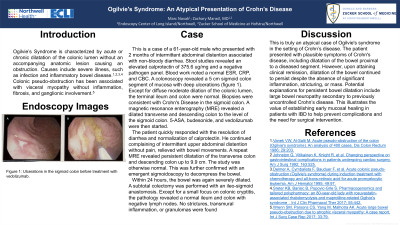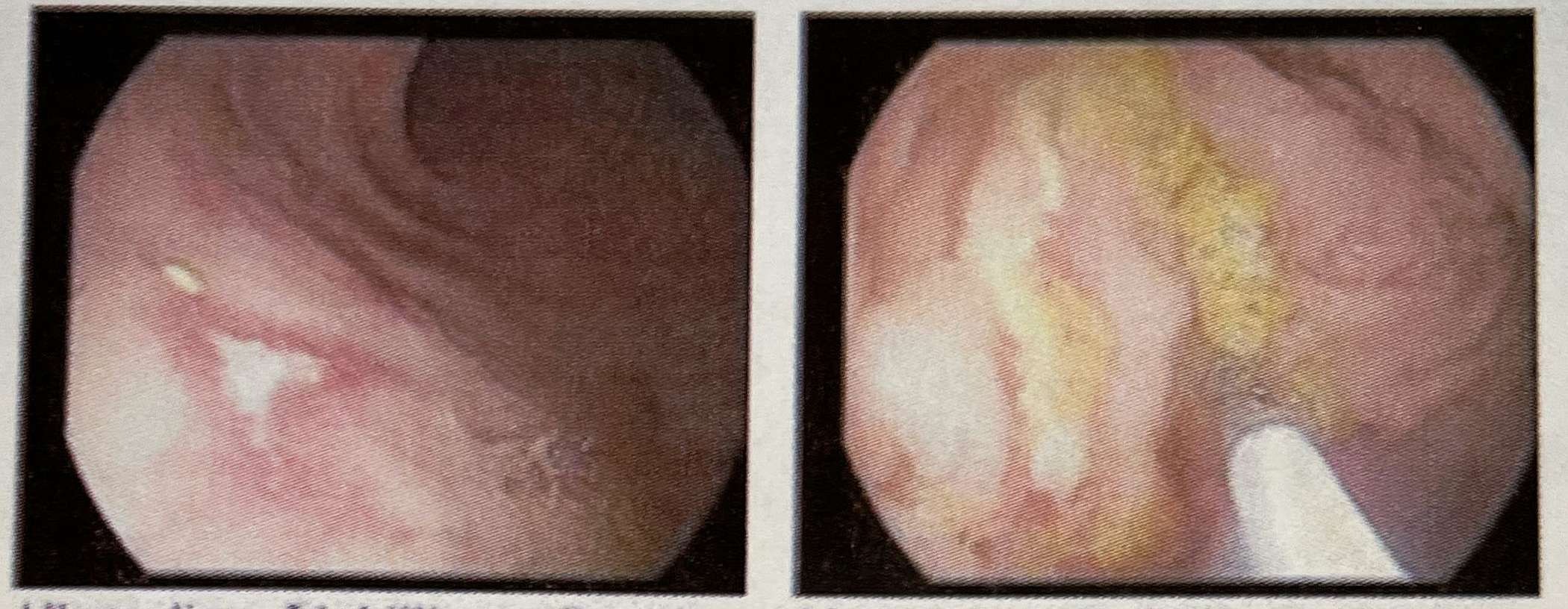Tuesday Poster Session
Category: IBD
P3663 - Ogilvie's Syndrome: An Atypical Presentation of Crohn’s Disease
Tuesday, October 24, 2023
10:30 AM - 4:00 PM PT
Location: Exhibit Hall

Has Audio
- MN
Marc Novak, BA
Northwell Health Endoscopy Center of Long Island
Garden City, NY
Presenting Author(s)
Marc Novak, BA, Zachary Marwil, MD
Northwell Health Endoscopy Center of Long Island, Garden City, NY
Introduction:
Olgilvie’s Syndrome is characterized by acute or chronic dilatation of the colonic lumen without an accompanying anatomic lesion causing an obstruction. Causes include severe illness, such as infection and inflammatory bowel disease. Colonic pseudo-obstruction has been associated with visceral myopathy without inflammation, fibrosis, and ganglionic involvement.
Case Description/Methods: This is a case of a 61-year-old male who presented with 2 months of intermittent abdominal distention with non-bloody diarrhea. Stool studies revealed an elevated calprotectin of 375.6 ug/mg and a negative pathogen panel. Blood work noted a normal ESR, CRP, and CBC. A colonoscopy revealed a 5 cm sigmoid colon segment of mucosa with deep ulcerations (figure 1). Except for diffuse moderate dilation of the colonic lumen, the terminal ileum and colon were normal. Biopsies were consistent with Crohn's Disease in the sigmoid colon. A magnetic resonance enterography (MRE) revealed a dilated transverse and descending colon to the level of the sigmoid colon. 5-ASA, budesonide, and vedolizumab were then started.
The patient quickly responded with resolution of diarrhea and normalization of calprotectin. He continued to complain of intermittent upper abdominal distention without pain, relieved with bowel movements. A repeat MRE revealed persistent dilatation of the transverse colon and descending colon up to 9.9 cm. The study was otherwise normal. This was further confirmed with an emergent sigmoidoscopy to decompress the bowel.
Within 24 hours, the bowel was again severely dilated. A subtotal colectomy was performed with an ileo-sigmoid anastomosis. Except for a small focus on colonic cryptitis, the pathology revealed a normal ileum and colon with negative lymph nodes. No strictures, transmural inflammation, or granulomas were found.
Discussion: This is truly an atypical case of Olgilivie’s syndrome in the setting of Crohn’s disease. The patient presented with plausible symptoms of Crohn's disease, including dilatation of the bowel proximal to a diseased segment. However, upon attaining clinical remission, dilatation of the bowel continued to persist despite the absence of significant inflammation, stricturing, or mass. Potential explanations for persistent bowel dilatation include large bowel neuropathy secondary to previously uncontrolled Crohn’s disease. This illustrates the value of establishing early mucosal healing in patients with IBD to help prevent complications and the need for surgical intervention.

Disclosures:
Marc Novak, BA, Zachary Marwil, MD. P3663 - Ogilvie's Syndrome: An Atypical Presentation of Crohn’s Disease, ACG 2023 Annual Scientific Meeting Abstracts. Vancouver, BC, Canada: American College of Gastroenterology.
Northwell Health Endoscopy Center of Long Island, Garden City, NY
Introduction:
Olgilvie’s Syndrome is characterized by acute or chronic dilatation of the colonic lumen without an accompanying anatomic lesion causing an obstruction. Causes include severe illness, such as infection and inflammatory bowel disease. Colonic pseudo-obstruction has been associated with visceral myopathy without inflammation, fibrosis, and ganglionic involvement.
Case Description/Methods: This is a case of a 61-year-old male who presented with 2 months of intermittent abdominal distention with non-bloody diarrhea. Stool studies revealed an elevated calprotectin of 375.6 ug/mg and a negative pathogen panel. Blood work noted a normal ESR, CRP, and CBC. A colonoscopy revealed a 5 cm sigmoid colon segment of mucosa with deep ulcerations (figure 1). Except for diffuse moderate dilation of the colonic lumen, the terminal ileum and colon were normal. Biopsies were consistent with Crohn's Disease in the sigmoid colon. A magnetic resonance enterography (MRE) revealed a dilated transverse and descending colon to the level of the sigmoid colon. 5-ASA, budesonide, and vedolizumab were then started.
The patient quickly responded with resolution of diarrhea and normalization of calprotectin. He continued to complain of intermittent upper abdominal distention without pain, relieved with bowel movements. A repeat MRE revealed persistent dilatation of the transverse colon and descending colon up to 9.9 cm. The study was otherwise normal. This was further confirmed with an emergent sigmoidoscopy to decompress the bowel.
Within 24 hours, the bowel was again severely dilated. A subtotal colectomy was performed with an ileo-sigmoid anastomosis. Except for a small focus on colonic cryptitis, the pathology revealed a normal ileum and colon with negative lymph nodes. No strictures, transmural inflammation, or granulomas were found.
Discussion: This is truly an atypical case of Olgilivie’s syndrome in the setting of Crohn’s disease. The patient presented with plausible symptoms of Crohn's disease, including dilatation of the bowel proximal to a diseased segment. However, upon attaining clinical remission, dilatation of the bowel continued to persist despite the absence of significant inflammation, stricturing, or mass. Potential explanations for persistent bowel dilatation include large bowel neuropathy secondary to previously uncontrolled Crohn’s disease. This illustrates the value of establishing early mucosal healing in patients with IBD to help prevent complications and the need for surgical intervention.

Figure: Figure 1: Ulcerations in the sigmoid colon before treatment with vedolizumab.
Disclosures:
Marc Novak indicated no relevant financial relationships.
Zachary Marwil indicated no relevant financial relationships.
Marc Novak, BA, Zachary Marwil, MD. P3663 - Ogilvie's Syndrome: An Atypical Presentation of Crohn’s Disease, ACG 2023 Annual Scientific Meeting Abstracts. Vancouver, BC, Canada: American College of Gastroenterology.
